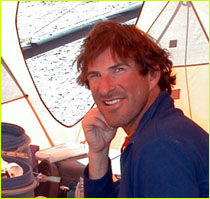
|
 |
 |
Dave Hahn Dave Hahn hales from Taos, New Mexico, and has worked as a mountain guide for 14 years. NOVA: So, you're here on Everest. Why? HAHN: Why? That's the big question isn't it? You try not to answer it the same way twice. The easiest answer is that it's part of my job. I guess by now I do have a long history on Everest. I first came in 1991. It was my first Himalayan trip. I got to 28,000 feet on that trip, about the First Step on the North Ridge. I came back in '94, and had nothing but epics on that trip. I got to the top, but it was ridiculous. I got a lot out of it, but I didn't get everything I wanted out of Everest on that trip. So, I came back last year leading an expedition for Eric and that was a big challenge for me and I got a bunch more of what I was looking for, but I still haven't gotten everything I want from it. It's a big mountain and I think there's a lot I can take away from it, if I'm careful. Last year I got to 28,000 feet, and this year coming back...I don't know, every time someone asks me why, I answer something different, and I guess it's because none of the answers are all that true... It's certainly a mountain that fascinates me. It's got these mysteries about it. Certainly the obvious mysteries like the Mallory and Irvine mystery, but there are also the personal mysteries. NOVA: Do you think Mallory and Irvine made it to the summit? HAHN: I have trouble believing they could have made it to the top in 1924. That doesn't mean I don't want to go looking into it. That doesn't mean I don't want to find out that they did it. But I do have trouble believing that they did it, partly out of my own experience. I mean, I'm not the best climber in the world, but I can be a strong climber, and I had an incredible experience on the Second Step and I thought it was a bit much. I was pretty impressed with the route; the thought to me that somebody on their first time up there just basically waltzed through those difficulties and found their way on a fairly involved route in the matter of hours that the old story allows for—I guess I have a little trouble with that. But, to tell the truth, I have trouble believing that they were as high as we know that they were anyway. And so, maybe I'll be surprised. Maybe I'll find something that changes my outlook. NOVA: How do you think they perished? What happened to them on that day? HAHN: Well, my thinking about how people die up there has changed a little bit. At first, the obvious thought is that people fall off the North Ridge. There's just exposure up there; you�re looking 9,000 feet down the North Face and when you get up on the Northeast Ridge proper, well then you're looking down 9 or 10,000 feet on the Kangshung. And so it's natural to think about falling. But thinking through it more recently it occurs to me that the more normal thing that happens to a climber up there is that they get dead-ended. It's just a constant series of little puzzles that you're trying to solve, none of them terrifically difficult, but all of them a little bit complicated. One after another after another, particularly when you're trying to get down and you've been up that high for so long, to me it starts to seem natural that at a certain point you get to a spot where you can't go forward and it doesn't look so simple to go back anymore and you just sit down to rest and after awhile you've spent too much time there and you probably just end up giving up, without necessarily overtly giving up. It just happens that way. You become mentally and physically exhausted and don't make that next move that [you fear might] result in a fall. Back to The Search Lost on Everest | High Exposure | Climb | History & Culture | Earth, Wind, & Ice E-mail | Previous Expeditions | Resources | Site Map | Everest Home Editor's Picks | Previous Sites | Join Us/E-mail | TV/Web Schedule About NOVA | Teachers | Site Map | Shop | Jobs | Search | To print PBS Online | NOVA Online | WGBH © | Updated November 2000 |
 Dave Hahn
Dave Hahn